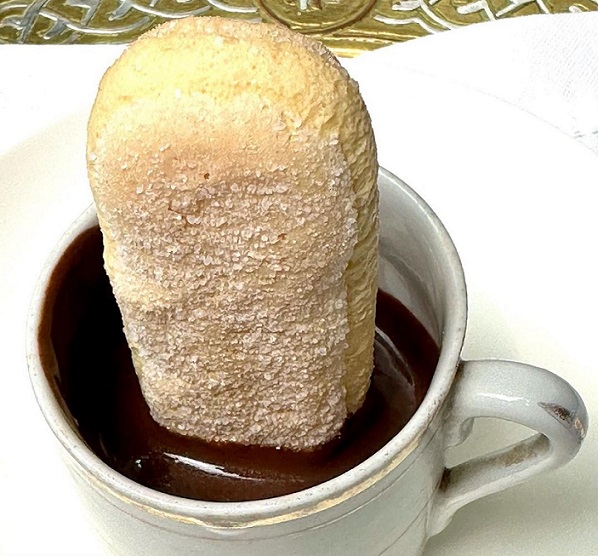
Images courtesy of R.C. Ladrido, Felice Prudente Sta. Maria, and Lutong Cavite Blog
If you have ever visited Iloilo City, you would have surely brought back some biscocho, kinihad, or even pinasugbo, dried saba slices coated in caramelized sugar, and wrapped in a white paper cone.
Sopas de Molo
Traditional bakeries still abound in the country. Some are well known than others because of their historical cachet associated with a town’s culinary heritage. In Iloilo, such bakeries would include Panaderia de Molo located in Molo, the old parian or Chinatown of Iloilo. In Silay, Negros Occidental, it would be El Ideal Bakery, both over a hundred years old, and still carrying biscuits that made their mark under Spanish colonial rule.
A glance at a local panaderia in Iloilo will reveal a variety of biscuits, with Spanish or local names: hojaldres, broas, paciencia, paborita, ugoy-ugoy, lubid-lubid, rosquetes, serafina, pulceras, and many more.

Collectively known as Sopas de Molo, it would include galletas, bañadas, hojaldres kinamunsil, biscocho principe, biscocho de caña, etc., as mentioned by Doreen G. Fernandez in her book, Tikim, Essays on Philippine Food and Culture (1994).
In general, the term sopas refers to soups/broths and biscuits in Iloilo, Negros, and Cebu at the turn of the century. Iloilo is well known for four kinds of sopas— Lapaz batchoy, pancit Molo, binacol (a chicken soup dish cooked in green bamboo node), and the fourth, Sopas de Molo or the biscuits of Panaderia de Molo.
The making of sopas or traditional biscuits is closely associated with our chocolate drinking habit that has almost disappeared today.
What’s in a name?
Iloilo’s biscuits are usually named after fruits and flowers, their natural shapes, or the process of making the biscuit. For example, kinamonsil is named and shaped after a fruit, kamunsil in Hiligaynon or camachile in Tagalog, known as Manila Tamarind; sinambag, a biscuit shaped like a tamarind fruit; pulceras, round like a bracelet, or bañadas, a round biscuit bathed in white frosting. Kinihad is named after the process of slicing the bread through a mechanical slicer. It literally means “sliced” (kihad) in Hiligaynon and refers to twice-baked and toasted slices of bread.
Early biscuit ads

Early bakeries advertised their biscuits in Iloilo’s newspapers. Pabrica de Sopas y Dulces, owned by a Japanese firm, described its products as “Lucky barquillos and a wide variety of biscuits and sweets in Makinaugalingon, December 3, 1919.
A Chinese-owned bakery, Panaderia ni Kuong Sing, described its biscuits as delicious and homemade, like those of imported tin biscuits from Europe and America, also in Makinaugalingon, March 13, 1920.

Tsokolate-eh and sopas
The habit of drinking chocolate in demitasse cups several times in a day lasted until early 20th century,
Travelers and missionaries in the 19th century wrote down that chocolate drinks in the Philippines were served with Savoy biscuits, small-finger shaped sponge biscuits similar to ladyfingers or broas. Much later, its variants, included biscuits called camachile or lengua de gato.

Thick chocolate (tsokolate-eh) was the preferred one, so thick that a spoon could stand on it. And to get the last remaining chocolate in the cup, sopas came to be: anything solid served with a cup of chocolate, a piece of bread or biscuit, roasted yam or sweet potato, or rice cakes to mop up the remaining liquid such as chocolate or sauce.
Sopas in other places
In Cebu, the tradition of “tsokolate ug sopas” means a serving of thick chocolate with a sponge biscuit, a boiled saba, or even a thick slice of sweet potato or the Cebuano bodbod, glutinous rice mixed with raw cane sugar, and wrapped in banana leaves.
In Tanza, Cavite, Kaibigan Bakery founded in 1920, still makes its well-known Sopas Tanza, circular or S-shaped biscuits. One of its owners recounted that they had a Cebuano baker who introduced the biscuit in their bakery and told them that in Cebu, the term sopas refers to biscuits or bread.

Felice P. Sta. Maria in The Food of Jose Rizal (2012) wrote that in his first overseas trip to Europe in 1882, Jose Rizal visited the Valenzuelas, and they gave him a can of cookies called sopas to bring in his voyage, meant to accompany a cup of chocolate during merienda.
Spanish influences
Under Spanish colonial rule (1565-1868), Spanish influence on Philippine language is seen in Spanish words related to food and cooking: asokal (azucar) cane sugar, calubaza (calabaza) squash; compites (confites), sweets; pritos (freir) to fry; horno, the beehive-shaped oven for baking bread; mantika (manteca) pork lard; longanisa (longaniza) pork sausage; masa (masa) dough; and baka (vaca) beef.
The word sopas comes from the Spanish word sopear, to sop up, and not from sopa, the Spanish word for soup.
As food historian Felice Prudente Sta Maria has suggested, maybe, we should revive the practice of drinking tsokolate-eh with sopas, long missing in our merienda fare nowadays. And with it, revive the word sopas for biscuits, as well.
